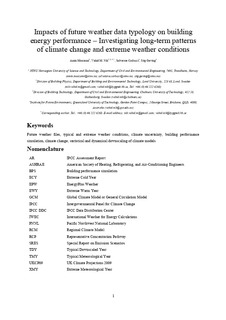| dc.contributor.author | Moazami, Amin | |
| dc.contributor.author | Nik, Vahid | |
| dc.contributor.author | Carlucci, Salvatore | |
| dc.contributor.author | Geving, Stig | |
| dc.date.accessioned | 2019-04-02T11:14:45Z | |
| dc.date.available | 2019-04-02T11:14:45Z | |
| dc.date.created | 2019-01-17T11:09:37Z | |
| dc.date.issued | 2019 | |
| dc.identifier.citation | Applied Energy. 2019, 238 696-720. | nb_NO |
| dc.identifier.issn | 0306-2619 | |
| dc.identifier.uri | http://hdl.handle.net/11250/2592910 | |
| dc.description.abstract | Patterns of future climate and expected extreme conditions are pushing design limits as recognition of climate change and its implication for the built environment increases. There are a number of ways of estimating future climate projections and creating weather files. Obtaining adequate representation of long-term patterns of climate change and extreme conditions is, however, challenging. This work aims at answering two research questions: does a method of generating future weather files for building performance simulation bring advantages that cannot be provided by other methods? And what type of future weather files enable building engineers and designers to more credibly test robustness of their designs against climate change? To answer these two questions, the work provides an overview of the major approaches to create future weather data sets based on the statistical and dynamical downscaling of climate models. A number of weather data sets for Geneva were synthesized and applied to the energy simulation of 16 ASHRAE standard reference buildings, single buildings and their combination to create a virtual neighborhood. Representative weather files are synthesized to account for extreme conditions together with typical climate conditions and investigate their importance in the energy performance of buildings. According to the results, all the methods provide enough information to study the long-term impacts of climate change on average. However, the results also revealed that assessing the energy robustness of buildings only under typical future conditions is not sufficient. Depending on the type of building, the relative change of peak load for cooling demand under near future extreme conditions can still be up to 28.5% higher compared to typical conditions. It is concluded that only those weather files generated based on dynamical downscaling and that take into consideration both typical and extreme conditions are the most reliable for providing representative boundary conditions to test the energy robustness of buildings under future climate uncertainties. The results for the neighborhood explaining the critical situation that an energy network may face due to increased peak load under extreme climatic conditions. Such critical situations remain unforeseeable by relying solely on typical and observed extreme conditions, putting the climate resilience of buildings and energy systems at risk. | nb_NO |
| dc.language.iso | eng | nb_NO |
| dc.publisher | Elsevier | nb_NO |
| dc.title | Impacts of the future weather data type on the energy simulation of buildings – Investigating long-term patterns of climate change and extreme weather conditions | nb_NO |
| dc.type | Journal article | nb_NO |
| dc.type | Peer reviewed | nb_NO |
| dc.description.version | submittedVersion | nb_NO |
| dc.source.pagenumber | 696-720 | nb_NO |
| dc.source.volume | 238 | nb_NO |
| dc.source.journal | Applied Energy | nb_NO |
| dc.identifier.doi | https://doi.org/10.1016/j.apenergy.2019.01.085 | |
| dc.identifier.cristin | 1659102 | |
| dc.relation.project | Norges forskningsråd: 257660 | nb_NO |
| dc.description.localcode | Publisher embargo until March 15, 2021 | nb_NO |
| cristin.unitcode | 194,64,91,0 | |
| cristin.unitname | Institutt for bygg- og miljøteknikk | |
| cristin.ispublished | true | |
| cristin.fulltext | preprint | |
| cristin.qualitycode | 1 | |
